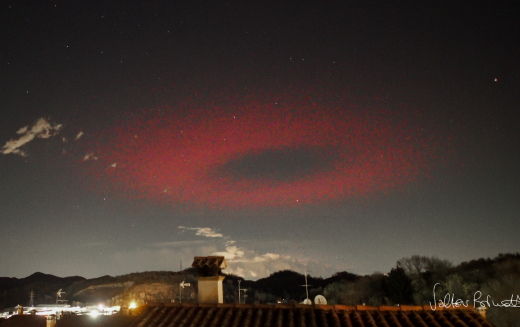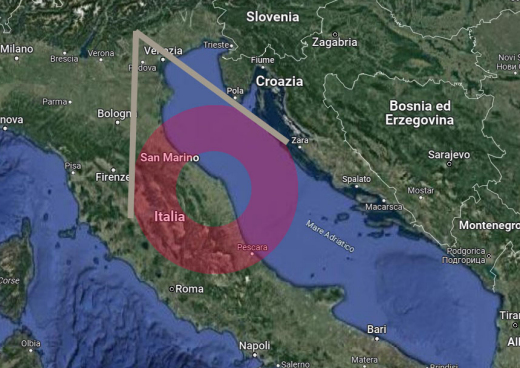
#ELVE OVER #ITALY: For a few milliseconds last Monday night, March 27th, an enormous red ring of light appeared in the sky over central Italy. Valter Binotto photographed it from the small town of Possagno in the foothills of the Italian Alps:
This is an "ELVE"--short for Emissions of Light and Very Low Frequency Perturbations due to Electromagnetic Pulse Sources. It's a rare species of sprite discovered in 1990 by cameras onboard the space shuttle. Binotto may have just taken the best ever picture of one from the ground.
"The ELVE was generated by intense lightning in a storm near Ancona about 285 km south of me," says Binotto. One bolt was so strong, it generated an intense electromagnetic pulse (EMP). The red ring marks the spot where the EMP hit Earth's ionosphere. Normal lightning bolts carry 10 to 30 kilo-ampères of current; this bolt was about 10 times stronger than normal.
Binotto created a graphic showing the scale of the ELVE:

Never miss another geomagnetic storm. Sign up for Space Weather Alerts and you'll receive a text message when magnetic storms erupt. Aurora tour guides and professional astronomers use this service. You can, too!
QUIET WEEKEND: Solar activity is low this weekend as multiple sunspots are in decay and pose no threat for strong solar flares. NOAA forecasters say the chance of M- or X-class flares is no more than 1%. Aurora alerts: SMS Text.
AN ELVE OVER ITALY: For a few milliseconds last Monday night, March 27th, an enormous red ring of light appeared in the sky over central Italy. Valter Binotto photographed it from the small town of Possagno in the foothills of the Italian Alps:
This is an "ELVE"--short for Emissions of Light and Very Low Frequency Perturbations due to Electromagnetic Pulse Sources. It's a rare species of sprite discovered in 1990 by cameras onboard the space shuttle. Binotto may have just taken the best ever picture of one from the ground.
"The ELVE was generated by intense lightning in a storm near Ancona about 285 km south of me," says Binotto. One bolt was so strong, it generated an intense electromagnetic pulse (EMP). The red ring marks the spot where the EMP hit Earth's ionosphere. Normal lightning bolts carry 10 to 30 kilo-ampères of current; this bolt was about 10 times stronger than normal.
Binotto created a graphic showing the scale of the ELVE:
"It was about 100 km high and nearly 360 km wide," says Binotto. "I have been photographing upper atmospheric lightning and transient luminous events (TLEs) since 2019, hundreds of them, and this is one of the biggest structures I have ever seen."
ELVE season is just getting started in Europe and North America, where spring and summer thunderstorms will multiply in the months ahead.

